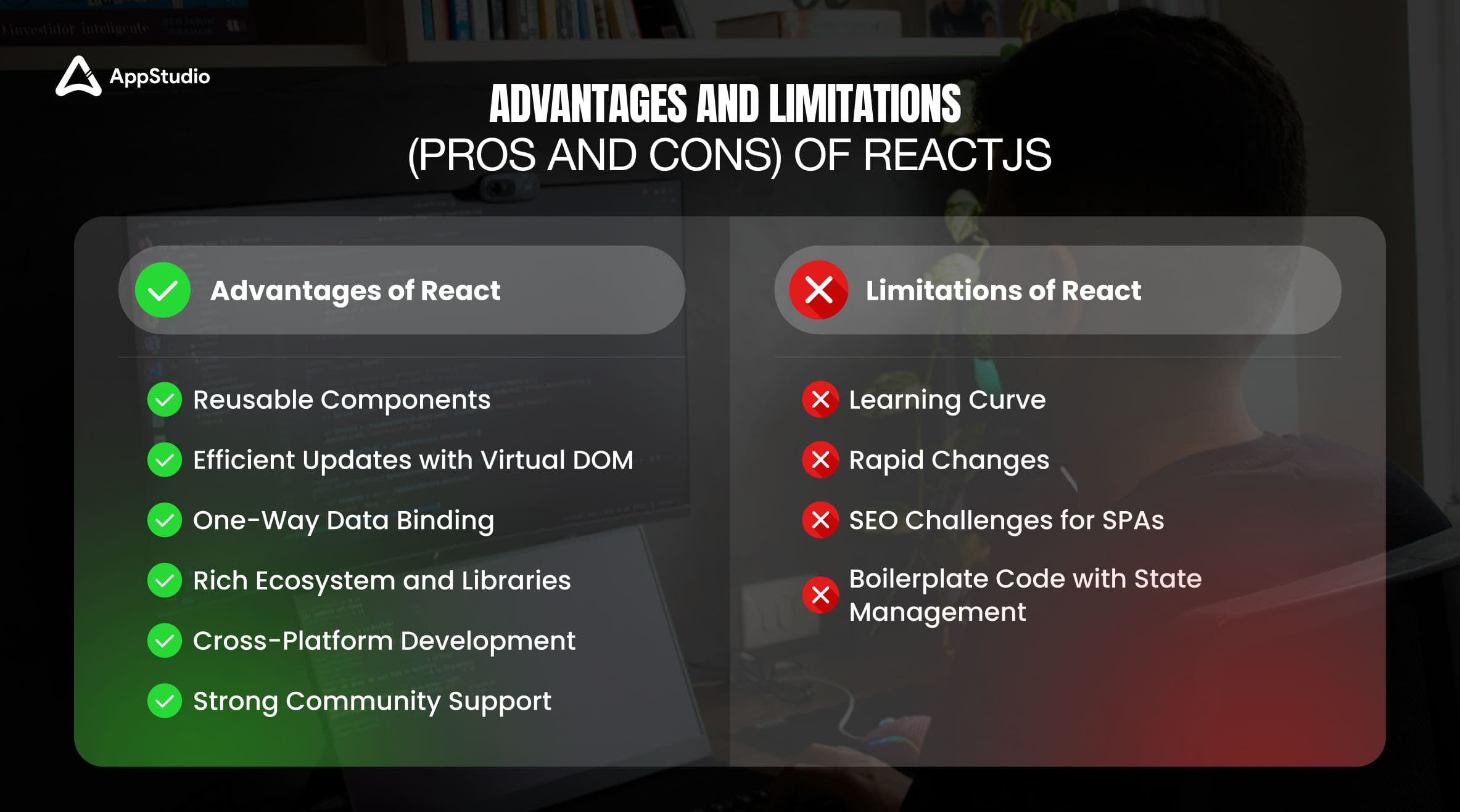In the fast-paced world of web development, technologies are constantly evolving. New frameworks, libraries, and tools are being introduced every year to make the development process more efficient and user-friendly. One such technology that has revolutionized front-end development is React.
But what is React js exactly, and why has it become such a dominant force in the world of web development? Whether you’re a seasoned developer or just beginning your journey into the world of coding, understanding React can provide you with the tools and knowledge needed to create modern, interactive user interfaces (UIs).
In this blog post, we will dive deep into what React is, why it’s popular, and how it works. We will also explore its key features, its ecosystem, and how you can get started with React development.
What is React?
React is one of the most popular JavaScript libraries used for building user interfaces, particularly for single-page applications (SPAs). It was developed by Facebook and is now maintained by Facebook and a community of developers. React makes it easier to build complex UIs by breaking them down into reusable components, which simplifies development and enhances user experience.
But, if you’re new to web development, you might be wondering: What is React? How does it fit into modern web development? This article aims to answer these questions and more. We will explore what React is used for, how it works, and why it has become one of the leading technologies in web development.
Related reading:A Beginner’s Guide to React Native App Development
What is React in JavaScript?
To answer the question “What is React in JavaScript?” let’s start with some context. JavaScript is the foundation for web development. It powers the dynamic and interactive elements of modern websites. React is a library built using JavaScript, but it is specifically focused on building user interfaces (UIs).
React allows developers to create large web applications that can change data, without reloading the page. This makes it ideal for building dynamic and fast applications. React provides a simple way to break down complex user interfaces into smaller, manageable pieces known as “components.” Each component is a piece of UI that you can reuse throughout the app, making the development process efficient.
What is React JS and How It Works?

You might be wondering, what is meant by React JS and how it works. React works by using a virtual DOM (Document Object Model). When you make changes to a React component, React doesn’t immediately update the real DOM (which is often slow). Instead, it creates a virtual DOM and compares it to the previous version of the virtual DOM. After calculating the most efficient way to update the real DOM, React applies only the necessary changes. This approach minimizes the number of updates and boosts performance, making React apps faster and more efficient.
When people talk about React JS, they are referring to the JavaScript library React. React JS is essentially the same thing as React, but “JS” is often added to clarify that it’s based on JavaScript. What is meant by React JS is simply that it’s a JavaScript library used for building UIs, particularly in single-page applications.
ReactJS History
To understand what is React JS and how it fits into the modern web development landscape, it’s important to know a bit about its history.
React was created by Jordan Walke, a software engineer at Facebook, who was looking for a better way to build UIs for Facebook’s highly dynamic platform. Initially released in 2013 as an open-source library, React was meant to solve the challenges developers faced when building scalable user interfaces. The main goal was to improve performance by making UI updates more efficient, thanks to React’s virtual DOM.
Before React, developers had to manually manipulate the DOM, which was both slow and inefficient, especially for large applications. React introduced a revolutionary approach by using the virtual DOM, which keeps a lightweight representation of the actual DOM in memory and updates only the parts that need to change.
React’s adoption grew quickly because of its simplicity and flexibility. It also introduced JSX, a syntax extension that allows HTML and JavaScript to be combined, making the code easier to read and write. Over time, other libraries like React Router and Redux were developed to complement React’s ecosystem, expanding its capabilities even further.
Industry Trends
React’s rise in popularity can be attributed to several industry trends. Let’s take a closer look at some of the key factors:
- Single-Page Applications (SPAs): React is optimized for SPAs, where the entire application is loaded initially, and updates to the UI happen dynamically without reloading the page. This trend of creating dynamic, faster, and more engaging user experiences made React the perfect fit for developers.
- Component-Based Architecture: Modern web development has shifted towards component-based architectures. React’s focus on reusable components allows developers to break down complex applications into smaller, more manageable pieces. This modular approach is both scalable and easier to maintain.
- Cross-Platform Development: React Native, a framework built on top of React, allows developers to write mobile applications using the same principles as React. This trend of cross-platform development—writing code once and running it across different platforms—has been a game-changer for React’s adoption.
- Virtual DOM and Performance: The need for faster, more efficient web applications has driven React’s use of the virtual DOM. The virtual DOM significantly reduces the time and resources needed to update the UI, especially for large-scale applications with frequent changes.
Related reading:All-In-One Guide To Pick The Best React Native Experts
Advantages and Limitations (Pros and Cons) of ReactJS

Like any technology, React JS has its advantages and limitations. Let’s take a look at both:
Advantages of React
- Reusable Components: React’s component-based architecture means you can create reusable components, which promotes cleaner, more maintainable code. These components can be shared across different parts of the application, improving development speed and reducing redundancy.
- Efficient Updates with Virtual DOM: React’s virtual DOM optimizes the rendering process. When there’s a change in the application, React creates a new virtual DOM, compares it with the previous one, and then only applies the necessary updates to the actual DOM. This approach improves performance, especially in large applications.
- One-Way Data Binding: React follows a unidirectional data flow, which makes it easier to manage data across components. This one-way binding ensures that the data only flows in one direction, reducing complexity and making the app more predictable.
- Rich Ecosystem and Libraries: React has a large ecosystem with a variety of libraries and tools that help with routing (React Router), state management (Redux), form handling (Formik), and more. This rich ecosystem allows developers to quickly implement features without reinventing the wheel.
- Cross-Platform Development: With React Native, developers can use the same concepts from React to build mobile apps for both iOS and Android development. This reduces the need for learning separate frameworks for different platforms.
- Strong Community Support: React has a vast and active community of developers who contribute to the library’s development and maintain a wealth of resources, tutorials, and third-party libraries. This makes React an excellent choice for beginners and experienced developers alike.
Limitations of React
- Learning Curve: Although React is easier to pick up than some alternatives, it does require an understanding of certain concepts like JSX, the virtual DOM, and hooks. For newcomers to JavaScript or web development, this can be overwhelming.
- Rapid Changes: React’s ecosystem evolves rapidly, and keeping up with all the new features, updates, and best practices can be challenging. For example, the introduction of hooks in React 16.8 changed how components are written, which led to a shift in how many developers approach React development.
- SEO Challenges for SPAs: While React excels at building SPAs, search engine optimization (SEO) can be tricky because the content is loaded dynamically. Though solutions like server-side rendering (SSR) or Next.js can address this, it requires additional setup and configuration.
- Boilerplate Code with State Management: React itself is minimalistic, which means developers often need to rely on third-party libraries like Redux for state management. This can introduce boilerplate code and make the development process more complex, especially for small projects.
Related reading:Top 7 Mistakes to Avoid While Developing React Native Apps
Features of React
React comes with a number of features that make it stand out as a leading JavaScript library for front-end development:
- JSX (JavaScript XML): JSX is a syntax extension that allows HTML-like code to be written directly within JavaScript. JSX makes it easier to visualize the structure of the component and provides a more declarative way of creating UIs.
- Component-Based Architecture: React’s core philosophy is to break down the UI into smaller, reusable components. Each component can have its own state, logic, and rendering logic. This makes it easy to manage and scale large applications.
- React Hooks: Introduced in React 16.8, hooks allow developers to use state and other React features without writing class-based components. Hooks like useState, useEffect, and useContext have simplified the development process and made React more intuitive.
- Virtual DOM: React uses a virtual DOM to improve performance. The virtual DOM is a lightweight copy of the real DOM, and React compares the new virtual DOM with the previous one to determine the most efficient way to update the UI.
- Unidirectional Data Flow: React uses a one-way data flow, which means that data flows in one direction, making the app’s state easier to manage and debug. This ensures that changes in the state of a component automatically trigger updates in its child components.
Components in React
In React, the user interface is built with components. A component is a JavaScript function or class that accepts inputs (called props) and returns a description of what should be displayed (in the form of JSX). Components are the heart of React applications.
There are two types of components in React:
- Functional Components: These are simple JavaScript functions that take props as arguments and return JSX. They are often used for components that don’t need internal state or lifecycle methods.
- Class Components: Class components extend the React.Component class and are used when you need more features, such as lifecycle methods or internal state management.
Both types of components are used to break down the UI into smaller, reusable pieces. A complex UI can be composed of multiple nested components, each handling a specific part of the UI.
ReactJS Examples
To understand what ReactJS can do, let’s look at some real-world examples:
- Facebook: Facebook itself was one of the first major applications to use React. React enables Facebook to handle dynamic content like comments, feeds, and notifications without reloading the page.
- Instagram: Instagram is another popular app built using React. It uses React for the entire front-end, including its dynamic photo feeds, stories, and real-time notifications.
- Airbnb: Airbnb uses React to power its listing pages, search results, and dynamic booking interface. React helps manage the real-time updates on property availability and price changes.
- Netflix: Netflix uses React for building its user interface, especially the parts that need frequent updates, such as movie recommendations, viewing history, and streaming quality.What is React JS?
Related reading: React Native Pros and Cons for Mobile App Development
Conclusion
What is React JS in a nutshell? React is a powerful and flexible JavaScript library used for building user interfaces. It has revolutionized the way developers create dynamic, interactive UIs for the web and mobile platforms. With its component-based architecture, virtual DOM, and strong community support, React continues to lead the charge in modern web development.
Whether you are a beginner just getting started with web development or an experienced developer looking to build scalable applications, React provides a wealth of tools, features, and best practices to streamline the process.
By understanding React’s history, advantages, features, and limitations, you can better leverage this technology to build robust, high-performance applications. So, dive into React today and start building the next generation of web apps!
Frequently Asked Questions
React is primarily used for building user interfaces, particularly for single-page applications (SPAs). It allows developers to break down complex UIs into reusable components that manage their own state and can efficiently update the UI when necessary. React is important in web development because it offers performance optimization through its virtual DOM, enables a component-based architecture, and simplifies the development of dynamic web applications. It is used to create highly interactive websites and applications that require frequent, real-time updates.
React JS (or React.js) is a JavaScript library developed by Facebook to build fast and interactive user interfaces for web applications. Unlike other JavaScript libraries, React’s core concept is the component-based architecture, where the UI is broken into small, reusable components. It also uses the virtual DOM to optimize the performance of rendering changes to the user interface. React is unique because it simplifies the development of dynamic and real-time user interfaces, and it’s highly efficient when working with large applications.
React JS is a powerful JavaScript library used for building user interfaces, especially in single-page applications (SPAs). It works by breaking down the UI into small, reusable components, each of which has its own state and can be updated independently. React uses a virtual DOM to improve performance: instead of updating the entire web page when changes occur, React updates only the specific parts of the page that need to change. This results in a faster and more efficient way to render updates and provides a smoother user experience.
React in JavaScript is a library that enables developers to build dynamic, interactive, and high-performance user interfaces. It simplifies the development process by offering features like components and the virtual DOM. React’s declarative syntax, using JSX, makes it easier for developers to write and visualize the UI structure directly within JavaScript. By using React, developers can manage complex UIs more effectively, improve the app’s performance with efficient rendering, and keep the codebase clean and maintainable.
React JS is used because of its ability to build highly interactive and scalable applications. React simplifies the development of single-page applications (SPAs) with a component-based architecture, where each component handles its own logic and rendering. React is also preferred for its virtual DOM feature, which ensures that updates are fast and efficient by minimizing direct manipulation of the real DOM. React’s focus on reusability, simplicity, and performance has made it the preferred choice for developers building large-scale applications like Facebook, Instagram, and Airbnb.
JavaScript React (or simply React) is a JavaScript library developed to streamline the creation of interactive and dynamic UIs. Unlike traditional JavaScript, which requires manual DOM manipulation, React abstracts this process using a virtual DOM, enabling efficient updates. JavaScript React allows developers to define components as building blocks for the UI, making development faster and more modular. With its robust ecosystem, React integrates well with other tools and libraries to create feature-rich applications, particularly for single-page applications and real-time apps.





